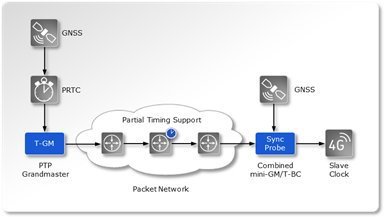Assisted partial timing support: Assured delivery of precise time and phase synchronisation

Rising demand for mobile broadband services and the evolution of cellular networks toward higher capacities and new air interfaces create a need to evolve existing synchronisation network architectures. Driven by the rollout of TD-LTE, public access small cells and LTE-Advanced functionalities such as Enhanced Inter-Cell Interference Coordination (eICIC) and Coordinated Multipoint (CoMP) transmission, radio base station clocks are now required to operate in phase with sub-microsecond accuracy in addition to legacy frequency synchronisation.
Precise phase synchronisation of radio base stations can be achieved by two fundamentally different technologies. Building a network-based timing architecture utilises the IEEE 1588v2 Precision Time Protocol (PTP) for distributing timing information from a centrally located PTP Grandmaster device to the slave clocks situated at cell site locations. Alternatively, a precise timing signal can be retrieved from a dedicated Global Navigation Satellite System (GNSS) receiver deployed at cell site locations. Both technology options come with benefits and challenges when it comes to precision, availability and operational simplicity.
Assisted partial timing support (APTS) was developed as a new concept integrating the benefits of both technologies. The main idea behind this approach is using GNSS as the primary time reference at cell site locations or at an aggregation point close to the cell sites, complemented by network-based timing distribution to assist and maintain the time base during holdover periods when GNSS tracking is not available. Precise and accurate clock behaviour during holdover periods longer than 72 hours is consequently assured, significantly reducing the challenge of network operations. A mini-Grandmaster deployed at cell tower hub sites can act as a timing reference for the local base station and slave clocks operating in subtended cell sites including public access small cells
Smart cities, built from scratch
With their reliance on interconnected systems and sustainable technologies, smart cities present...
Smart homes, cities and industry: Wi-Fi HaLow moves into the real world
Wi-Fi HaLow's reported advantages include extended ranges and battery life, minimised...
Five ways data storage can advance your sustainability ambitions
With IT a significant contributor to energy consumption, there are considerable sustainability...







